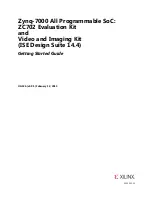C8051F930-DK
Rev. 0.5
23
11.
When the missing clock detector is enabled, why does the MCU reset if I switch from the default system
clock (Low Power Oscillator divided by 8) to smaRTClock divided by 1?
Background:
—The missing clock detector will trigger a reset if the system clock period exceeds 100 µs.
—Switchover between clock sources occurs in 1 clock cycle of the slowest clock.
—Changing the clock divide value requires up to 128 cycles of the undivided clock source.
Since the
clock source
change occurs in a single cycle and the
clock divide
change can take up to 128
cycles, the system clock will be set to the
new clock source divided by the old divide value
for a brief period
of time. In this example, the actual system clock will be 4.096 kHz for up to 128 cycles of the undivided clock
source. This causes the missing clock detector to time out and reset the MCU.
The proper way of changing the system clock when both the
clock source
and the
clock divide
value are
being changed is as follows:
If switching from a fast “undivided” clock to a slower “undivided” clock:
a. Change the
clock divide
value.
b. Poll for CLKRDY > 1.
c. Change
the
clock source
.
If switching from a fast “undivided” clock to a slower “undivided” clock:
d. Change the
clock source
.
e. Change the
clock divide
value.
f. Poll for CLKRDY > 1.
12.Why is the MCU pre-maturely released from reset when using a wall supply with a slow rise time?
The maximum VDD Ramp Time is specified at 3 ms. If the power supply ramp takes longer than 3 ms to reach
0.9 V, then the device may be released from reset before the supply has reached the minimum operating
voltage. The slow ramp time (>3 ms) can occur when using a bench power supply that does not have an output
enable switch.
Downloaded from
Elcodis.com
electronic components distributor


















